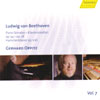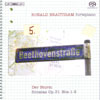Beethoven Piano Sonatas, Vol. 7
Three strong cycles offer power, illumination – and some irritation
View record and artist detailsRecord and Artist Details
Composer or Director: Ludwig van Beethoven
Genre:
Instrumental
Label: Hänssler
Magazine Review Date: 10/2007
Media Format: CD or Download
Media Runtime: 68
Mastering:
Stereo
DDD
Catalogue Number: CD98207

Tracks:
| Composition | Artist Credit |
|---|---|
| Sonata for Piano No. 22 |
Ludwig van Beethoven, Composer
Gerhard Oppitz, Piano Ludwig van Beethoven, Composer |
| Sonata for Piano No. 24 |
Ludwig van Beethoven, Composer
Gerhard Oppitz, Piano Ludwig van Beethoven, Composer |
| Sonata for Piano No. 29, 'Hammerklavier' |
Ludwig van Beethoven, Composer
Gerhard Oppitz, Piano Ludwig van Beethoven, Composer |
Composer or Director: Ludwig van Beethoven
Genre:
Instrumental
Label: ECM New Series
Magazine Review Date: 10/2007
Media Format: CD or Download
Media Runtime: 75
Mastering:
Stereo
DDD
Catalogue Number: 476 5875

Tracks:
| Composition | Artist Credit |
|---|---|
| Sonata for Piano No. 12 |
Ludwig van Beethoven, Composer
András Schiff, Piano Ludwig van Beethoven, Composer |
| Sonata for Piano No. 14, 'Moonlight' |
Ludwig van Beethoven, Composer
András Schiff, Piano Ludwig van Beethoven, Composer |
| Sonata for Piano No. 15, 'Pastoral' |
Ludwig van Beethoven, Composer
András Schiff, Piano Ludwig van Beethoven, Composer |
Composer or Director: Ludwig van Beethoven
Genre:
Instrumental
Label: BIS
Magazine Review Date: 10/2007
Media Format: CD or Download
Media Runtime: 68
Mastering:
Stereo
DDD
Catalogue Number: BIS-SACD1572

Tracks:
| Composition | Artist Credit |
|---|---|
| Sonata for Piano No. 16 |
Ludwig van Beethoven, Composer
Ludwig van Beethoven, Composer Ronald Brautigam, Fortepiano |
| Sonata for Piano No. 17, 'Tempest' |
Ludwig van Beethoven, Composer
Ludwig van Beethoven, Composer Ronald Brautigam, Fortepiano |
| Sonata for Piano No. 18, 'Hunt' |
Ludwig van Beethoven, Composer
Ludwig van Beethoven, Composer Ronald Brautigam, Fortepiano |
Author: Jed Distler
Oppitz’s one-time teacher Wilhelm Kempff favoured an intimate style of Beethoven-playing that finds a more overtly “worked out” and textually scrupulous parallel via András Schiff. He is not one to unleash the Moonlight? Sonata’s third movement’s fury, to let the Op 27 No 1 Scherzo scamper like Schnabel, or to sufficiently contrast the Op 26 finale’s lightly cascading toccata-like patterns and bravura descending scales. Instead, Schiff takes great pains to distinguish slurred and staccato articulation, with results that are either impossibly mannered (the Moonlight’s Allegretto) or stylishly revealing (Op 26’s Scherzo and Op 28’s Andante). Yet whether the performances illuminate or irritate, Schiff consistently conveys a sense of timbral differentiation between registers akin to the instruments of Beethoven’s time, together with their unique pedal effects. For example, listen to the pungent resonance of the bass notes in the Op 26 first-movement minore variation, or how the vaporous haze of the Moonlight’s celebrated Adagio sostenuto never turns muddy. In contrast to heavier, rhetorical readings, Schiff’s straightforward interpretation takes Beethoven’s alla breve marking at face value.
If Schiff aims to transform his Steinway into an early-18th-century fortepiano, Ronald Brautigam pushes his Paul McNulty instrument to its dynamic limits yet remains in total physical control. Like Richard Goode, Brautigam subtly modifies the basic pulse of Op 31 No 1’s first movement exposition without softening the “kerplop” effect of Beethoven’s deliberately un-synchronised hands. Similar freedom and proportion govern the finale, while graceful rumination colours the long central movement’s decorative arabesques. In the Tempest Sonata, the Adagio’s haunting phrases easily float over the bar-lines, providing a respite to the headlong intensity Brautigam stirs up in the outer movements. Op 31 No 3 is equally outstanding. The Menuetto particularly showcases this fortepiano’s twangy, harpsichord-like overtones, while Brautigam uncompromisingly plunges into the Presto con fuoco at full speed with the detail radar cranked up, leaving no notes under the table.
Discover the world's largest classical music catalogue with Presto Music.

Gramophone Digital Club
- Digital Edition
- Digital Archive
- Reviews Database
- Full website access
From £8.75 / month
Subscribe
Gramophone Full Club
- Print Edition
- Digital Edition
- Digital Archive
- Reviews Database
- Full website access
From £11.00 / month
Subscribe
If you are a library, university or other organisation that would be interested in an institutional subscription to Gramophone please click here for further information.




